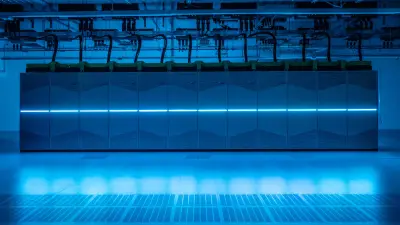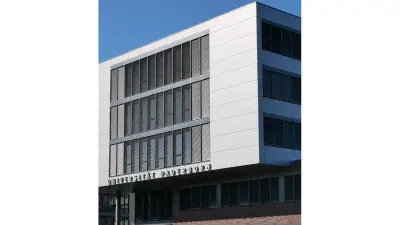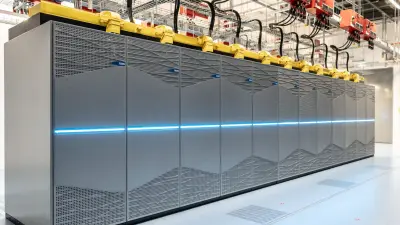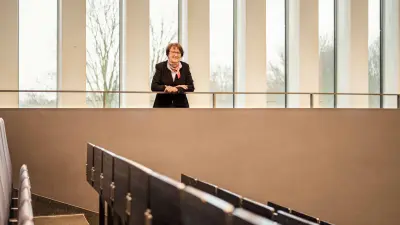Paderborn University’s “Green” Computer Center
Researchers rely on powerful technologies for developing state-of-the-art solutions to current and future challenges. And high-performance computing is regarded as a crucial technology in many fields of science. One of the keys for boosting the energy efficiency of high-performance data centers is cutting-edge building automation solutions, as Paderborn University’s collaboration with Bosch Energy and Building Solutions shows.

Paderborn University, which belongs to Germany’s National High-Performance Computing (NHR) network, is helping to shape the future. It already has two powerful supercomputers, dubbed Noctua 1 and Noctua 2, with a third scheduled to go online in late 2024. This makes it an elite member of the club of universities engaged in high-performance computing (HPC). The university is leveraging this concentrated computing power to drive quantum simulators and simulate atomistic systems, among other things, and lets researchers at other German universities take advantage of them free of charge.
Paderborn University, which belongs to Germany’s National High-Performance Computing (NHR) network, is helping to shape the future. It already has two powerful supercomputers, dubbed Noctua 1 and Noctua 2, with a third scheduled to go online in late 2024. This makes it an elite member of the club of universities engaged in high-performance computing (HPC). The university is leveraging this concentrated computing power to drive quantum simulators and simulate atomistic systems, among other things, and lets researchers at other German universities take advantage of them free of charge.

The high-performance data center at Paderborn University
Thanks to its Noctua supercomputers, the high-performance data center at Paderborn University ranks among the country’s top 10 universities engaged in this work and is at the forefront of research as a member of Germany’s Association for National High-Performance Computing. Researchers can participate in this endeavor by taking advantage of its immense computing power to perform simulations. The computers crunch gigantic volumes of data at lightning speed to detect patterns. “Noctua 2” alone has 140,000 processor cores.
Photocredit: Universität Paderborn Leonie Oberheuser
Building automation: at the interface between data centers and buildings
But high-performance computers consume huge amounts of energy and generate quite a bit of heat in the process. To strike an optimal balance, Paderborn University is relying on the expertise of Bosch Energy and Building Solutions. Bosch has optimized building automation in the university’s two data centers and other campus buildings. It has also synchronized both dynamic automation systems to supply the surrounding buildings with waste heat from the data centers.
Innovative cooling reduces energy consumption by two thirds
A special feature of “building X”, which houses the Noctua computers, is a power-saving two-megawatt cooling system. It’s designed to keep the supercomputers operating within an optimal temperature range year-round. The water used for direct water cooling is at temperatures above 35°C – so no refrigeration is needed, even on hot summer days. This has reduced the amount of energy needed for cooling by about two-thirds. The building automation system controls the processes involved to ensure energy-efficient operation.

Waste heat used to heat the campus buildings
In many cases, waste heat from cooling data centers goes unused – thus squandering a valuable source of energy. But not in Paderborn: there it’s channeled from the data center in building X straight to the campus heating plant as needed to meet requirements. The building automation system constantly monitors how much heat each campus building requires and how much is available from the computing center. The automation systems communicate with one another to ensure that only as much heat flows to a lecture hall or office as is actually needed there. This increases energy efficiency, lowers costs and can help to reduce emissions.

Building automation covers fault scenarios
This makes operating the data centers not only more efficient but also safer. Redundant automation strategies cover the entire range of fault scenarios. A network of redundant systems with dual supply paths ensures reliable cooling – even if other systems, controllers, or networks should fail.
The Bottom Line
This building automation solution is an important component for energy-efficient operation of Paderborn University’s high-performance data center. It’s a major step toward sustainably operating research facilities of this kind and sets an example for others to follow. Bitkom, Germany’s association for the information and telecommunications sector, has calculated that the country’s data centers together consume a total of 18 billion kWh of electricity annually*. But efficiency has increased six-fold thanks to new generations of hardware and software that have enabled their computing volume to grow faster than their need for power. This sector also regards using waste heat as an important lever for protecting the climate. The data centers give off enough of it to heat around 350,000 housing units. The German Energy Efficiency Act, which was passed in late 2023 and took effect in January 2024, requires increased use of waste heat and more energy-efficient operation of data centers. The goal is to reduce and reuse waste heat to the greatest possible extent.
*Source Bitkom



